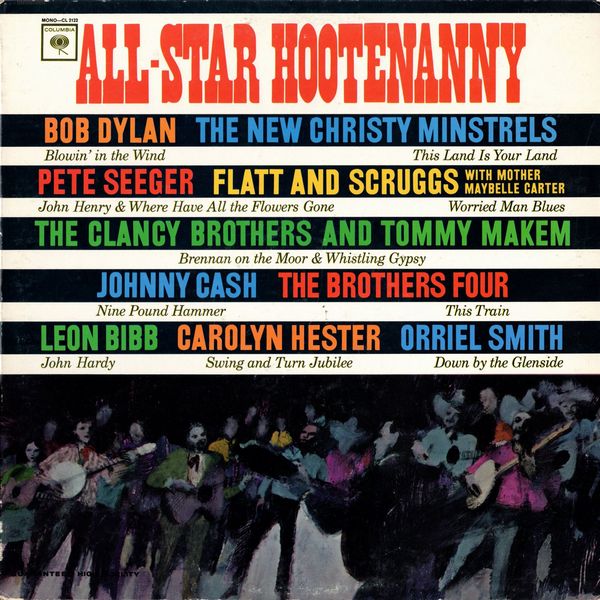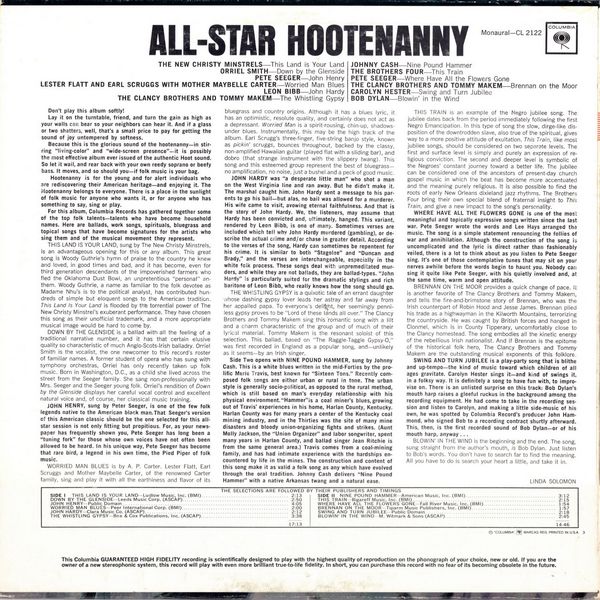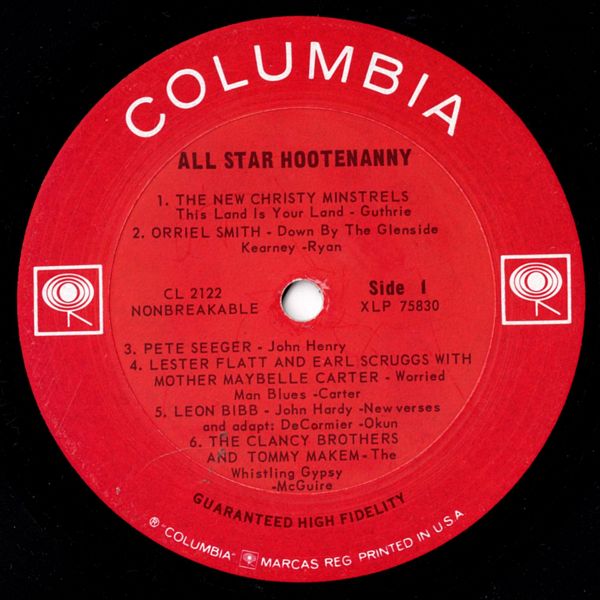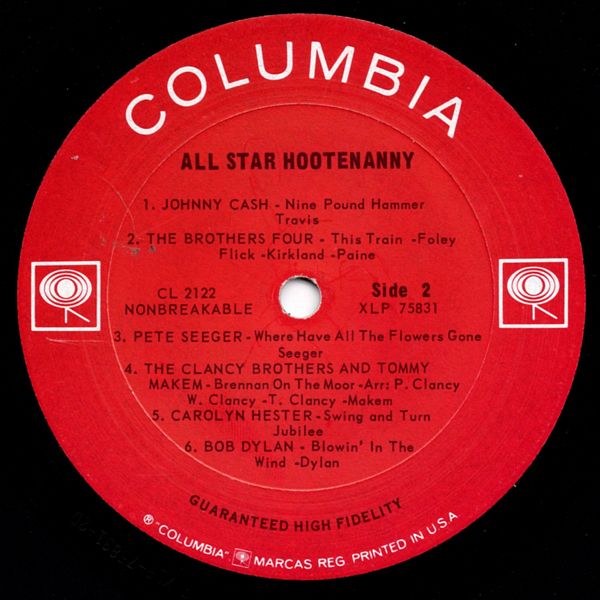
 |



|
Sleeve Notes
Don't play this album softly!
Lay it on the turntable, friend, and turn the gain as high as your walls can bear so your neighbors can hear it. And if a glass or two shatters, well, that's a small price to pay for getting the sound of joy untempered by softness.
Because this is the glorious sound of the hootenanny — in stirring "living-color" and "wide-screen presence" — it is possibly the most effective album ever issued of the authentic Hoot sound. So let it wail, and rear back with your own reedy soprano or beefy bass. It moves, and so should you — if folk music is your bag.
Hootenanny is for the young and for alert individuals who are rediscovering their American heritage — and enjoying it. The Hootenanny belongs to everyone. There is a place in the sunlight of folk music for anyone who wants it, or for anyone who has something to say, sing or play.
For this album, Columbia Records has gathered together some of the top folk talents — talents who have become household names. Here are ballads, work songs, spirituals, bluegrass and topical songs that have become signatures for the artists who sing them and of the musical movement they represent.
THIS LAND IS YOUR LAND, sung by The New Christy Minstrels, is an advantageous opening for this or any album. This great song is Woody Guthrie's hymn of praise to the country he knew and loved, in good times and bad, and it has become, even for third generation descendants of the impoverished farmers who fled the Oklahoma Dust Bowl, an unpretentious "personal" anthem. Woody Guthrie, a name as familiar to the folk devotee as Madame Nhu's is to the political analyst, has contributed hundreds of simple but eloquent songs to the American tradition. This Land Is Your Land is flooded by the torrential power of The New Christy Minstrel's exuberant performance. They have chosen this song as their unofficial trademark, and a more appropriate musical image would be hard to come by.
DOWN BY THE GLENSIDE is a ballad with all the feeling of a traditional narrative number, and it has that certain elusive quality so characteristic of much Anglo-Scots-lrish balladry. Orriel Smith is the vocalist, the one newcomer to this record's roster of familiar names. A former student of opera who has sung with symphony orchestras, Orriel has only recently taken up folk music. Born in Washington, D.C., as a child she lived across the street from the Seeger family. She sang non-professionally with Mrs. Seeger and the Seeger young folk. Orriel's rendition of Down by the Glenside displays her careful vocal control and excellent natural voice and, of course, her classical music training.
JOHN HENRY, sung by Peter Seeger, is one of the few folk legends native to the American black man. That Seeger's version of this American classic should be the one selected for this all-star session is not only fitting but propitious. For, as your newspaper has frequently shown you, Pete Seeger has long been a "tuning fork" for those whose own voices have not often been allowed to be heard. In his unique way, Pete Seeger has become that rare bird, a legend in his own time, the Pied Piper of folk music.
WORRIED MAN BLUES is by A. P. Carter. Lester Flatt, Earl Scruggs and Mother Maybelle Carter, of the renowned Carter family, sing and play it with all the earthiness and flavor of its bluegrass and country origins. Although it has a blues lyric, it has an optimistic, resolute quality, and certainly does not act as a depressant. Worried Man is a spirit-rousing, chin-up, shadows-under blues. Instrumentally, this may be the high track of the album. Earl Scrugg's three-finger, five-string banjo style, known as pickin' scruggs, bounces throughout, backed by the classy, non-amplified Hawaiian guitar (played flat with a sliding bar), and dobro (that strange instrument with the slippery twang). This song and this esteemed group represent the best of bluegrass — no amplification, no noise, just a bushel and a peck of good music.
JOHN HARDY was "a desperate little man" who shot a man on the West Virginia line and ran away. But he didn't make it. The marshal caught him. John Hardy sent a message to his parents to go his bail — but alas, no bail was allowed for a murderer. His wife came to visit, avowing eternal faithfulness. And that is the story of John Hardy. We, the listeners, may assume that Hardy has been convicted and, ultimately, hanged. This variant, rendered by Leon Bibb, is one of many. Sometimes verses are included which tell why John Hardy murdered (gambling), or describe the actual crime and/or chase in greater detail. According to the verses of the song, Hardy can sometimes be repentent for his crime. It is similar to both "Stagolee" and "Duncan and Brady," and the verses are interchangeable, especially in the white folk process. These songs deal with unpremeditated murders, and while they are not ballads, they are ballad-types. "John Hardy" is particularly suited for the dramatic stylings and rich baritone of Leon Bibb, who really knows how the song should go.
THE WHISTLING GYPSY is a quixotic tale of an errant daughter whose dashing gypsy lover leads her astray and far away from her appalled papa. To everyone's delight, her seemingly penniless gypsy proves to be "Lord of these lands all over." The Clancy Brothers & Tommy Makem sing this romantic song with a lilt and a charm characteristic of the group and of much of their lyrical material. Tommy Makem is the resonant soloist of this selection. This ballad, based on "The Raggle-Taggle Gypsy-O," was first recorded in England as a popular song, and — unlikely as it seems — by an Irish singer.
Side Two opens with NINE POUND HAMMER, sung by Johnny Cash. This is a white blues written in the mid-Forties by the prolific Merle Travis, best known for "Sixteen Tons." Recently composed folk songs are either urban or rural in tone. The urban style is generally socio-political, as opposed to the rural method, which is still based on man's everyday relationship with his physical environment. "Hammer"is a coal miner's blues, growing out of Travis' experiences in his home, Harlan County, Kentucky. Harlan County was for many years a center of the Kentucky coal mining industry, and in the Thirties was the site of many mine disasters and bloody union-organizing fights and strikes. (Aunt Molly Jackson, the "Union Organizer" and labor songwriter, spent many years in Harlan County, and ballad singer Jean Ritchie is from the same general area.) Travis comes from a coal-mining family, and has had intimate experience with the hardships encountered by life in the mines. The construction and content of this song make it as valid a folk song as any which have evolved through the oral tradition. Johnny Cash delivers "Nine Pound Hammer" with a native Arkansas twang and a natural ease.
THIS TRAIN is an example of the Negro jubilee song. The jubilee dates back from the period immediately following the first Negro Emancipation. In this type of song the slow, dirge-like disposition of the downtrodden slave, also true of the spiritual, gives way to a more positive attitude of exultation. This Train, like most jubilee songs, should be considered on two separate levels. The first and surface level is simply and purely an expression of religious conviction. The second and deeper level is symbolic of the Negroes' constant journey toward a better life. The jubilee can be considered one of the ancestors of present-day church gospel music in which the beat has become more accentuated and the meaning purely religious. It is also possible to find the roots of early New Orleans dixieland jazz rhythms. The Brothers Four bring their own special blend of fraternal insight to This Train, and give a new impact to the song's personality.
WHERE HAVE ALL THE FLOWERS GONE is one of the most meaningful and topically expressive songs written since the last war. Pete Seeger wrote the words and Lee Hays arranged the music. The song is a simple statement renouncing the follies of war and annihilation. Although the construction of the song is uncomplicated and the lyric is direct rather than fashionably veiled, there is a lot to think about as you listen to Pete Seeger sing. It's one of those contemplative tunes that may sit on your nerves awhile before the words begin to haunt you. Nobody can sing it quite like Pete Seeger, with his quietly involved and, at the same time, warm and open attitude.
BRENNAN ON THE MOOR provides a quick change of pace. It is another favorite of The Clancy Brothers & Tommy Makem, and tells the fire-and-brimstone story of Brennan, who was the Irish counterpart of Robin Hood and Jesse James. Brennan plied his trade as a highwayman in the Kilworth Mountains, terrorizing the countryside. He was caught by British forces and hanged in Clonmel, which is in County Tipperary, uncomfortably close to the Clancy homestead. The song embodies all the kinetic energy of the rebellious Irish nationalist. And if Brennan is the epitome of the historical folk hero, The Clancy Brothers & Tommy Makem are the outstanding musical exponents of this folklore.
SWING AND TURN JUBILEE is a play-party song that is blithe and up-tempo — the kind of music toward which children of all ages gravitate. Carolyn Hester sings it — and kind of swings it, in a folksy way. It is definitely a song to have fun with, to improvise on. There is an unlisted surprise on this track: Bob Dylan's mouth harp raises a gleeful ruckus in the background among the recording equipment. He had come to take in the recording session and listen to Carolyn, and making a little side-music of his own, he was spotted by Columbia Record's producer John Hammond, who signed Bob to a recording contract shortly afterward. This, then, is the first recorded sound of Bob Dylan — or of his mouth harp, anyway …
BLOWIN' IN THE WIND is the beginning and the end. The song, sung straight from the author's mouth, is Bob Dylan. Just listen to Bob's words. You don't have to search far to find the meaning. All you have to do is search your heart a little, and take it in.
LINDA SOLOMON